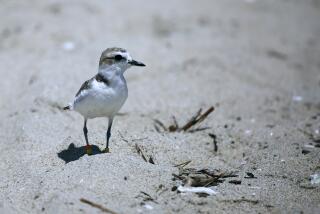Beach Closures Help Endangered Plovers : Massachusetts: With humans out of the way, the birds have been able to mate, have chicks and make a comeback.
- Share via
NEWBURYPORT, Mass. — Turning over some of the state’s most popular beaches to the birds has paid off. With no humans to contend with, more endangered piping plovers mated and had chicks this season.
The small, sand-colored birds feed on tiny creatures at the ocean’s edge. They don’t take food to their young; they bring the delicate chicks to the water with them.
The species has been nearly wiped out by coastal development, people frolicking on the beach and predators, such as house cats and gulls.
Preliminary counts this summer show higher counts of plover chicks compared to past seasons. Biologists say that proves that closing some of the state’s most popular beaches from April to August for several years is working.
The bird was added to the endangered species list in 1986, making it illegal to harm them. Enforcing the law often pits environmentalists against shop owners and sunbathers.
“I don’t think there was any need to close the beach,” said Kay Moulton, owner of Surfland Bait & Tackle. She said her Plum Island business in northeast Massachusetts was hurt by this spring’s announcement that 6.3 miles of beachfront would be closed.
“We’re a national wildlife refuge; we’re here to protect wildlife first, then people,” said John Fillio, a biologist at the island’s Park River National Wildlife Refuge.
This summer, five pairs of piping plovers produced 13 young on the deserted beach. Last year, 10 pairs gave birth to 14 chicks.
Several beaches in Cape Cod also were closed this summer, said state zoologist Scott Melvin.
Statewide, 140 pairs produced an average of 1.38 chicks last year, Melvin said. This year, his preliminary count shows that 155 pairs averaged 1.8 chicks.
Connecticut’s numbers are not as good. Last year, 43 pairs gave birth to 70 chicks there. This year’s estimate is 50 chicks from just 36 pairs.
“I wish I could close the beaches,” said Julie Victoria, wildlife biologist for Connecticut’s Department of Environmental Protection. “We are always going to be in competition with people for sandy beaches.”
New York, which has the Atlantic Coast’s largest plover population, relied largely on voluntary efforts to protect more than 200 nesting pairs, said Bob Miller of the state’s Division of Fish and Wildlife. Chick counts were not immediately available for New York.
Federal officials this fall will compare plover counts this year to 1990, when volunteers counted 739 pairs from Maine to North Carolina and about 230 in Canada, said Anne Hecht, a biologist for the federal Fish and Wildlife Service.
An average of 1.06 chicks were produced by each pair last year. The federal government’s goal is to average two chicks per pair, Hecht said.
More to Read
Sign up for Essential California
The most important California stories and recommendations in your inbox every morning.
You may occasionally receive promotional content from the Los Angeles Times.













